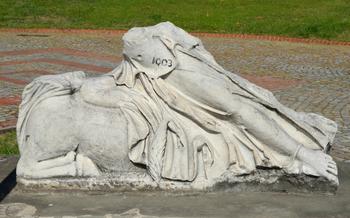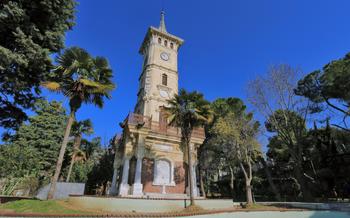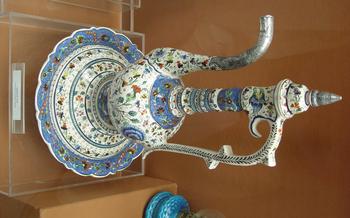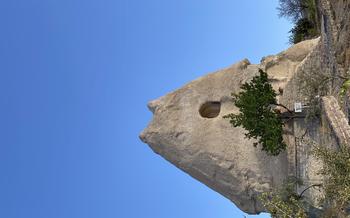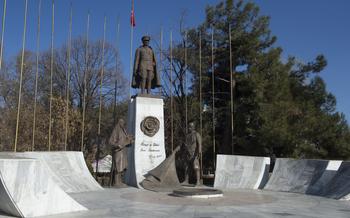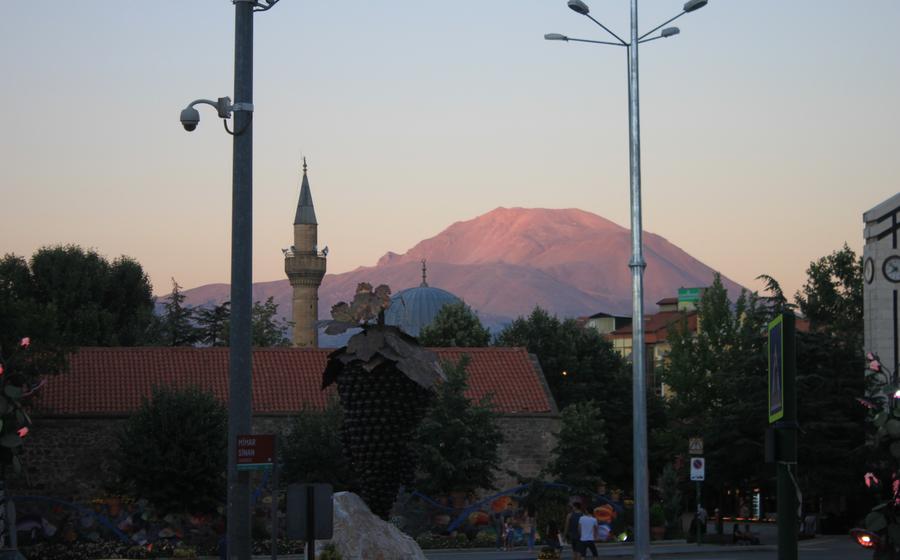
Antioch of Pisidia Archeological Museum
- History of the Antioch of Pisidia Archaeological Museum
- Location and Accessibility
- Museum Highlights
- Exploring the Collections
- Ancient Artifacts
- Unique Exhibits
- Interactive Displays
- Educational Programs
- Visitor Facilities
- Local Culture and History
- Accessibility and Inclusion
- Sustainable Tourism
- Community Involvement
- Insider Tip: Unveiling Hidden Gems and Local Delights
History of the Antioch of Pisidia Archaeological Museum
The Antioch of Pisidia Archaeological Museum stands as a testament to the rich cultural heritage of Isparta, Turkey. Established in 1972, the museum houses a vast collection of artifacts unearthed from the ancient city of Antioch of Pisidia, a prominent city during the Roman era. The museum's inception marked a significant milestone in preserving and showcasing the region's archaeological treasures. Over the years, it has undergone several expansions and renovations to accommodate its growing collection and improve visitor experiences.
Past excavations at the Antioch of Pisidia site have yielded a wealth of artifacts, providing valuable insights into the city's history and culture. These discoveries have played a crucial role in shaping the museum's exhibits and narratives, offering visitors a glimpse into the region's storied past. The museum's dedication to preserving and showcasing Isparta's cultural heritage has made it a renowned institution, attracting visitors from around the world.
Location and Accessibility
The Antioch of Pisidia Archaeological Museum is conveniently nestled in the heart of Isparta, a city brimming with historical charm and natural beauty. Situated at Adnan Menderes Bulvarı, No:25, it is easily accessible by both public and private transportation. To immerse yourself in the museum's treasures, simply hop on a bus or minibus headed towards the city center and alight at the Museum stop. If you're driving, there are ample parking spaces available nearby, ensuring a hassle-free visit.
Once you arrive at the museum, you'll be greeted by a welcoming and knowledgeable staff who are always ready to assist you. Take advantage of the guided tours offered in various languages to gain in-depth insights into the museum's fascinating exhibits. By combining your visit with a stroll through Isparta's vibrant streets, you can delve deeper into the city's rich cultural tapestry and uncover hidden gems waiting to be discovered.
Museum Highlights
The Antioch of Pisidia Archaeological Museum boasts an impressive collection of artifacts that showcase the rich history and cultural heritage of Isparta. Among the must-see exhibits are the stunning mosaics that adorn the floors of the ancient city. These intricate artworks depict mythological scenes, geometric patterns, and portraits of historical figures, offering a glimpse into the artistic prowess of the region's past inhabitants.
Another highlight of the museum is the collection of sculptures, which includes both life-size statues and smaller figurines. These sculptures range from depictions of gods and goddesses to everyday people, providing insights into the religious beliefs, social customs, and daily life of the ancient Pisidians.
Don't miss the impressive collection of pottery, which umfasst a wide variety of styles and forms. From simple household vessels to elaborately decorated vases, these artifacts showcase the skill and artistry of the region's potters. The museum also houses a collection of coins, jewelry, and other small objects that offer a glimpse into the economic and social activities of the ancient city.
Exploring the Collections
The museum's diverse collection is organized into thematic sections or galleries, each shedding light on a different aspect of Isparta's rich history and culture. One gallery focuses on the region's ancient past, displaying pottery, sculptures, and mosaics from the Neolithic to the Roman periods. These artifacts offer a glimpse into the daily lives of the people who inhabited this region centuries ago, from their domestic activities to their religious beliefs.
Another gallery showcases the Byzantine and Seljuk eras, showcasing intricate iconography and architectural elements that reflect the region's diverse cultural influences. Visitors can admire the delicate craftsmanship of Byzantine mosaics and the grandeur of Seljuk tilework, gaining insights into the artistic and religious traditions that flourished during these periods.
The museum also dedicates a section to the Ottoman period, presenting a collection of textiles, manuscripts, and metalwork that highlight the region's contributions to the vast Ottoman Empire. Visitors can learn about the administrative structure, economic activities, and cultural practices that shaped Isparta during this influential era.
Finally, a contemporary art gallery showcases works by local and international artists, providing a platform for modern artistic expression and encouraging dialogue on current social and cultural issues. This gallery reflects the museum's commitment to promoting contemporary art and fostering cultural exchange within the community.
Ancient Artifacts
The Antioch of Pisidia Archaeological Museum houses an impressive collection of pottery, sculptures, and mosaics from antiquity. These artifacts provide a glimpse into the daily lives, beliefs, and artistic traditions of the region's ancient inhabitants.
The pottery collection includes a variety of vessels, from simple utilitarian pieces to elaborately decorated vases and plates. The sculptures range from small figurines to life-size statues, depicting gods, goddesses, heroes, and ordinary people. The mosaics, often found in the ruins of ancient homes and public buildings, showcase intricate designs and scenes from mythology and everyday life.
One of the highlights of the pottery collection is a large storage jar known as a pithos. This impressive vessel, dating back to the 4th century BC, stands over 2 meters tall and is decorated with a frieze depicting a procession of animals. The sculptures include a well-preserved statue of the goddess Artemis, found in the nearby ancient city of Sagalassos. The goddess is depicted standing gracefully, holding a bow and arrow in her hands.
The museum also boasts a remarkable collection of mosaics, including a large floor mosaic from a Roman villa. The mosaic depicts scenes from the Trojan War, with intricate details and vibrant colors. Another notable mosaic shows a hunting scene, with a group of hunters pursuing a deer in a forest.
These ancient artifacts are not just beautiful works of art but also valuable sources of information about the history and culture of the region. They offer a tangible connection to the past, allowing visitors to imagine the lives of the people who created and used them centuries ago.
Unique Exhibits
Among the museum's many treasures, several unique or one-of-a-kind artifacts stand out from the rest. One such item is a remarkable stone relief depicting a procession of Roman soldiers and dignitaries. Carved with exquisite detail, the relief offers a glimpse into the military and political life of ancient Antioch. Another highlight is a well-preserved mosaic floor that once adorned a wealthy Roman villa. The mosaic features intricate geometric patterns and colorful depictions of animals and mythical creatures.
Another must-see exhibit is a collection of ancient coins that span several historical periods. These coins provide valuable insights into the economic and political history of the region, as well as the artistic and technical skills of the ancient craftsmen who minted them.
Finally, the museum showcases a unique collection of glass objects, including delicate perfume bottles, intricately designed drinking vessels, and colorful jewelry. These artifacts offer a glimpse into the everyday lives of the ancient inhabitants of Antioch, as well as their artistic and technological achievements.
Interactive Displays
The Antioch of Pisidia Archaeological Museum embraces technology to enhance the visitor experience through interactive displays. Touchscreens offer in-depth information about the artifacts, allowing visitors to explore at their own pace. Multimedia presentations and augmented reality experiences bring history to life, providing a multisensory journey through time. Interactive maps and timelines offer historical context, helping visitors understand the significance of the artifacts in relation to the broader region and era. Hands-on activities, such as virtual excavations and puzzle-solving games, engage visitors, especially children, and make learning fun and interactive. The museum also caters to visitors with disabilities, providing accessibility features such as audio guides, closed captions, and tactile exhibits.
Educational Programs
The Antioch of Pisidia Archaeological Museum offers a range of educational programs and resources to enhance the visitor experience and foster a deeper understanding of Isparta's rich cultural heritage.
Guided Tours:
- Knowledgeable museum guides lead guided tours for groups or individuals, providing insights into the history, significance, and context of the museum's exhibits. Tours can be tailored to specific interests or themes.
Workshops:
- The museum conducts workshops on various topics related to archaeology, history, and cultural studies. These workshops provide hands-on learning opportunities and allow participants to engage with experts and fellow enthusiasts.
Educational Resources:
- The museum houses a well-stocked library with a collection of books, journals, and research materials on Isparta's history and archaeology. Researchers and students can access these resources for their studies.
Lectures and Seminars:
- The museum regularly organizes lectures, seminars, and conferences featuring renowned scholars, archaeologists, and historians. These events provide a platform for knowledge sharing, discussion, and intellectual exchange.
Research Opportunities:
- The museum collaborates with universities and research institutions to facilitate ongoing research projects and excavations in the region. Visitors with a keen interest in archaeology may have the opportunity to contribute to these projects and gain valuable hands-on experience.
Visitor Facilities
The Antioch of Pisidia Archaeological Museum provides a range of facilities to enhance the visitor experience and ensure their comfort and convenience. To ensure you have a memorable and enjoyable visit, here's an overview of the facilities available.
-
Museum Shop: Discover a treasure trove of souvenirs, educational materials, books, and replicas inspired by the museum's collection. Take home a piece of history or a memento of your visit to cherish.
-
Café and Restaurant: After exploring the museum's wonders, indulge in a delightful meal or a refreshing beverage at the on-site café or restaurant. Enjoy a break while savoring local delicacies and refreshing drinks.
-
Restrooms and Lockers: Convenient restrooms are available within the museum for visitors' comfort. Additionally, lockers are provided for safekeeping of personal belongings while you immerse yourself in the exhibits.
-
Accessibility for All: The museum is committed to ensuring accessibility for visitors with disabilities. Ramps, elevators, and accessible exhibits enable visitors of all abilities to fully experience the museum's treasures.
Local Culture and History
The Antioch of Pisidia Archaeological Museum not only houses a treasure trove of ancient artifacts but also offers a glimpse into the vibrant local culture and history of Isparta. Through its displays, the museum showcases traditional crafts, costumes, and customs of the region, providing visitors with a deeper understanding of the area's rich heritage.
Exhibits on display highlight the unique traditions and practices that have shaped the identity of Isparta. Visitors can learn about the region's renowned carpet weaving, intricate embroidery, and distinctive pottery techniques. Traditional costumes, often adorned with colorful motifs and intricate designs, offer a glimpse into the local fashion and aesthetics.
The museum also sheds light on the history of Isparta, showcasing its role in shaping the region's identity. Visitors can explore displays that delve into the area's ancient past, its Byzantine heritage, and its transformation under Ottoman rule. Through these exhibits, the museum provides a comprehensive narrative of Isparta's journey through time.
To further enhance the visitor experience, the museum organizes cultural events and workshops that celebrate local traditions. Visitors can participate in hands-on activities, learn traditional crafts, and engage with local artisans. These events foster a sense of cultural exchange and provide a platform for visitors to connect with the living heritage of Isparta.
By immersing themselves in the local culture and history showcased at the Antioch of Pisidia Archaeological Museum, visitors gain a deeper appreciation for the region's unique identity and the diverse traditions that have shaped its people and their way of life.
Accessibility and Inclusion
The Antioch of Pisidia Archaeological Museum is dedicated to ensuring that everyone has the opportunity to experience and appreciate its rich collection. Accessibility features are in place to accommodate visitors with disabilities, creating a welcoming and inclusive environment. Ramps and elevators provide easy access to all floors of the museum, enabling wheelchair users to navigate the exhibits without barriers. Additionally, accessible exhibits and interactive displays are designed to cater to visitors with sensory or cognitive impairments. The museum's commitment to inclusivity extends beyond physical accessibility, as it offers special programs and events tailored for visitors with diverse needs. These initiatives demonstrate the museum's dedication to fostering a sense of belonging and ensuring that everyone can engage with the wonders of Isparta's cultural heritage.
Sustainable Tourism
The Antioch of Pisidia Archaeological Museum is committed to sustainable practices that minimize its environmental impact and promote responsible tourism. The museum has implemented various measures to conserve resources and reduce its carbon footprint. Renewable energy sources, such as solar panels, are used to generate electricity, and water-saving fixtures are installed throughout the facility. Recycling programs are in place for paper, plastic, and metal waste. Visitors are encouraged to adopt sustainable practices during their visit, such as using reusable water bottles and recycling their waste. The museum has partnered with local organizations to promote responsible tourism initiatives, such as bike-sharing programs and walking tours. By embracing sustainability, the Antioch of Pisidia Archaeological Museum sets an example for other cultural institutions and contributes to the preservation of the environment for future generations.
Community Involvement
The Antioch of Pisidia Archaeological Museum actively engages with the local community to foster cultural exchange and promote the region's rich heritage. Educational programs and workshops are organized for local residents, particularly children, to instill a sense of pride and appreciation for their cultural roots. The museum collaborates with local schools, universities, and community groups to develop educational initiatives and outreach programs. By partnering with these institutions, the museum aims to create a vibrant and inclusive cultural environment that benefits the entire community.
The museum serves as a hub for cultural activities and events, providing a platform for local artists, musicians, and performers to showcase their talents. These events not only entertain and engage the community but also contribute to the preservation and promotion of local traditions. The museum's commitment to community involvement extends beyond its walls, as it actively collaborates with local organizations to promote responsible tourism practices and sustainable development in the region.
Insider Tip: Unveiling Hidden Gems and Local Delights
As you delve into the depths of the Antioch of Pisidia Archaeological Museum, keep an eye out for secret spots and hidden treasures that may escape the notice of most visitors. Venture beyond the main exhibition halls to discover tucked-away corners that house lesser-known artifacts or offer stunning views of the surrounding landscape.
Plan your visit strategically to avoid the peak tourist hours and immerse yourself in a more intimate and tranquil museum experience. This will allow you to fully appreciate the exhibits without the distractions of large crowds.
Furthermore, stay informed about special events or exhibitions that may not be widely advertised but offer unique opportunities to engage with the museum's collection and delve deeper into the region's rich history and culture.
To enhance your visit, venture outside the museum walls and explore the culinary delights of Isparta. Discover local restaurants or cafes in the vicinity that offer authentic Turkish cuisine, allowing you to savor the flavors and traditions of this vibrant region. Engage with the locals, learn about their customs, and immerse yourself in the warmth and hospitality of Turkish culture.


